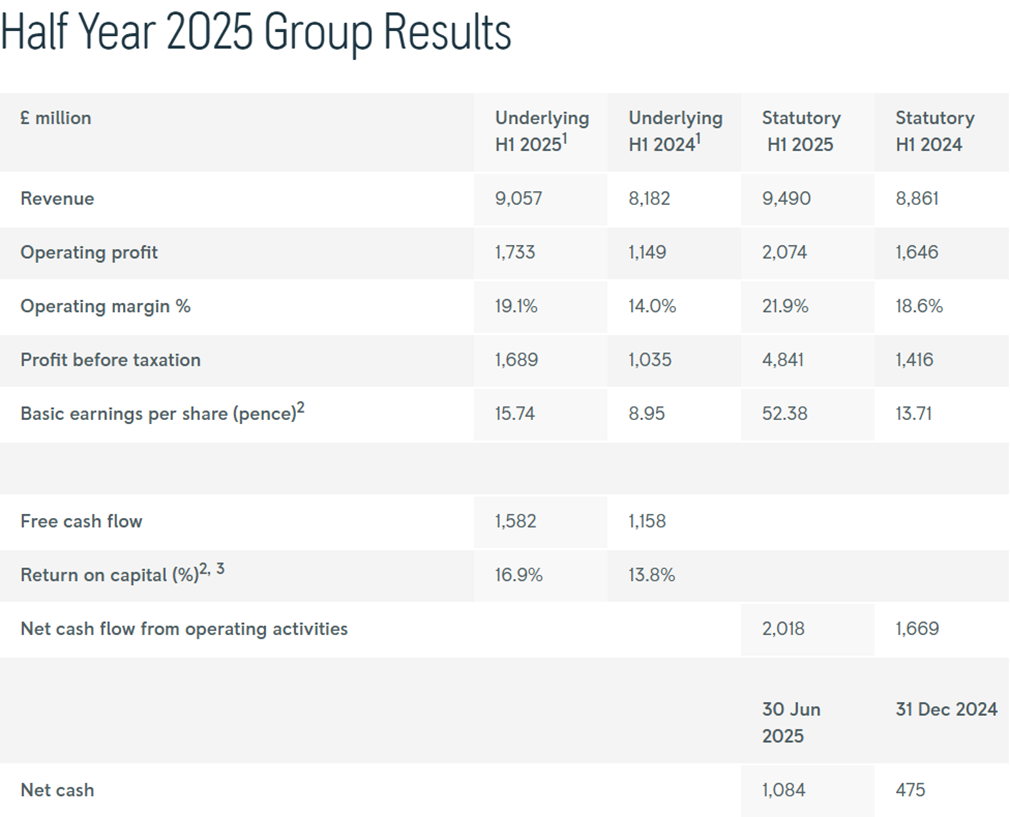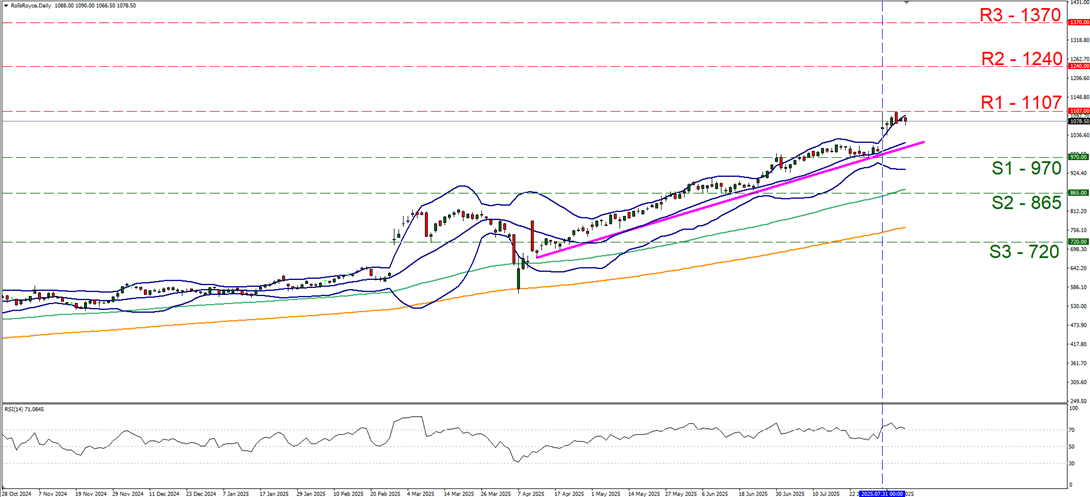Rolls-Royce outlook: Optimistic forecast for the power systems

For this week’s report we will explore a new prospective outlook for Rolls Royce. The holdings hit another Record High last week, leaving behind a positive tone for a continuation of this consistent rise in value. In this report we are to discuss the High Demand in aerospace engines after upgrades, Rolls Royce’s New deals with Škoda & Curtiss-Wright, Rise in Battery Storage & Green Technology and the results of H1 as well as the company’s forward guidance. The report will include a technical analysis of the Rolls-Royce Daily Chart.
Introductory note
Rolls-Royce Holdings plc is a global provider of mission-critical power systems founded in the United Kingdom in 1884. The company operates through four segments: Civil Aerospace, Defence, Power Systems, and New Markets. The Civil Aerospace segment develops, manufactures, markets, and sells aero engines for large commercial aircraft, regional jet, and business aviation markets and also offers aftermarket services. The Defence segment involves the development, manufacture, marketing and sale of military aero and naval engines, submarine nuclear power plants, while also it provides aftermarket services. The Power Systems segment focuses on developing, manufacturing, marketing, and selling integrated onsite power and propulsion solutions, by using the MTU brand name. Lastly, the New Markets segment is responsible for developing, manufacturing, and selling small modular reactors and innovative electrical power solutions.
High Demand in aerospace engines after upgrades
Rolls-Royce has attracted high demand from airlines for its latest engines, which are “Trend 1000” and “Pearl 10X”. Trent 1000 is designed to power Boeing 787 Dreamliner aircrafts. This engine is set to be a lot more durable with approximately almost twice as much airtime from the last engine. Unfortunately, Rolls-Royce had reliability issues with the engine which led to airlines using it like British Airways and Virgin Atlantic looking for alternatives elsewhere. The company took the initiative to improve the durability of Trent 1000 but also Trent 700 engines by the end of the year with the expectation of delivering up to 30% more wing time. The company also managed to sustain strong results despite the imposition of new, intimidating tariffs for its supply chain. Rolls-Royce is anticipating a higher demand after the engine’s upgrades, which can already be seen from the company’s most recent sale yesterday, of two Trend 700 sister engines to 3TOP. The company has also filed test reports for the Pearl 10X engine and it’s awaiting the approval to start selling. Lastly, the company could be benefited from the new UK-India free trade agreement, as it could strengthen the relationship between Rolls-Royce and India’s Aviation and Defence ecosystem. Overall, if the expected improvements are made in the next couple of years, the company’s value will continue to grow.
New deals with Škoda & Curtiss-Wright
Rolls-Royce SMR has signed a memorandum of understanding (MoU) with the Czech firm Škoda JS for the production of high-valued nuclear components for the company’s small modular reactors (SMRs), which could prospect future deployment globally. In a separate development, for the analysis, testing, and evaluation of critical SMR components, has signed another contract with the Czech ÚJV Řež. The UK government has already committed £2.5 billion for the construction of three SMR units, supplying electricity to around 3 million homes and creating up to 3,000 jobs with one of them being the Rolls-Royce SMR. In addition, Rolls-Royce has also come to a strategic agreement with UK-based Curtiss Wright which will provide design, qualification, testing and supply of the Non-programmable Diverse Reactor Protection Systems. The company is looking for a possible expansion in France too and specifically in Lyon focusing on SMRs. With the MoU signed, Rolls-Royce will be able to be a provider of secure and affordable electricity which will be very beneficial for the company.
Rise in battery storage and green technology
Rolls-Royce is currently advancing battery energy storage systems (BESS), with the largest order to date from the Lithuanian Ignitis Group. The company’s power systems expect a 20 per cent increase in data centre orders every year to 2030 with an annual growth of 15-17 per cent last February. Rolls-Royce is also making significant investments in the development of a next generation “mtu 2000” engine which will be used as engines for energy business, government business, fast yachts and commercial shifts. Set to launch in 2028, these advanced engines will deliver greater power density, reduced emissions, and improved fuel efficiency compared to competing products. Adding up to reducing the environmental impact, Rolls-Royce is looking to use e-fuels of the German cleantech company Ineratec for emergency power systems in data centres. E-diesel, made from green hydrogen and carbon dioxide will be provided as a substitute for fossil diesel in backup generators for the security of the energy supply for AI data centres. The company is looking for a new expansion for the data centres with possible locations in central Germany, like Friedrichshafen, Magdeburg, Augsburg and Ruhstorf. The company’s plan for an eco-friendlier system but also the high expectations for battery storages could be very beneficial for its stock’s price on a fundamental level.
High-yielding first semester of 2025
Rolls Royce had a breakthrough last semester, beating the estimations of analysts for the operating profit, reaching £1.19 billion, around £500 million more than the expected £686 million. Moreover, it has climbed in an impressive increase of 35% in value the past 2 months. The growth was a result of the high demand from the energy and government businesses, spanning both military and civil applications, like the Unity contract with the UK navy for their submarines’ nuclear reactors. Thus, a trust for the company’s moves was created with investors having an optimistic outlook for investing in its share.
The CEO of the company Tufan Erginbilgic after announcing the half-year results of the company send a positive message that the company is on track and will continue to be profitable while also having high expectations, strategic investments and making a global expansion. He also kept a positive tone for the next semester’s expectations. In his own words, “A strong start to the year gives us confidence to raise our guidance for 2025. We now expect to deliver underlying operating profit of £3.1bn-£3.2bn and free cash flow of £3.0bn-£3.1bn. This builds further conviction in our mid-term targets, which include underlying operating profit of £3.6bn-£3.9bn and free cash flow of £4.2bn-£4.5bn. We see these targets as a milestone, not a destination, with substantial growth prospects beyond the mid-term.”. These targets could potentially be accomplished leading to a big stock expansion of the company.
Conclusion on a fundamental level
All in consideration, Rolls-Royce strong performance in the first half of the year underscores the company’s successful execution of its strategies. This profitable semester gives Rolls-Royce hope for future expansion globally with innovative, forward-looking investments which could impact to positive growth to the company’s market value.
References:
Technical analysis
Rolls-Royce (Daily chart)
-
Support: 970 (S1), 865 (S2), 720 (S3).
-
Resistance: 1107 (R1), 1240 (R2), 1370 (R3).
In the past week, Rolls Royce market price had an overall bullish mentality. The market price is constantly rising and recently had its highest peak, at (1107) R1 which is now the first resistance barrier. We support that this bullish mentality could continue near but over the uptrend line (in pink). In the case of a bullish movement, the market price could possibly break the resistance line R1 (1107) and then it could possibly aim to break the other two resistance levels R2 (1240) and R3 (1370). Nevertheless, since the 31st of July the market price is near the higher Bollinger band and the RSI level has been over 70, which may imply that the market was overbought, and a correction lower could follow. Should a correction lower evolve into a full blown out bearish movement, the market price will break the uptrend line, in a first signal of an interruption of the share price’s upward movement, while also is required to break the S1 (970) support barrier and continue lower aiming to break the next one at the S2 (865).

